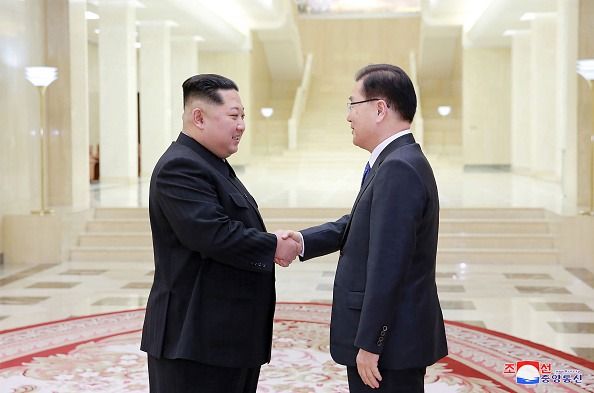The inter-Korean agreement and Pyongyang’s offer to Trump
By Duyeon Kim | March 8, 2018

North Korean leader Kim Jong-un has stepped up his peace offensive, playing a familiar game with his own particular flair. This week, South Korean presidential envoys returned to Seoul with news of having reached a six-point agreement with Pyongyang. South Korean national security advisor Chung Eui-yong then delivered the message to President Donald Trump that Kim Jong-un hopes to meet him soon—an invitation Trump accepted. The New York Times reported Thursday that White House press secretary Sarah Huckabee Sanders confirmed Trump would “meet with Kim Jong Un at a place and time to be determined. We look forward to the denuclearization of North Korea. In the meantime, all sanctions and maximum pressure must remain.”
It is certainly good news that the first-ever US-North Korea summit could take place this year. But the future remains uncertain and highly complicated because of their fundamentally opposed positions on the nuclear issue and many intertwined and complex regional issues.
Pyongyang’s latest overtures show that Kim wants to portray himself as a bold leader of a normal, peace-loving nuclear power who is willing to deal only with Washington—not Seoul—on the nuclear issue. His efforts this week are consistent with past attempts by North Korea to draw Seoul farther away from Washington, weaken the sanctions regime, and ensure its own survival. The inter-Korean agreement also fulfilled South Korean President Moon Jae-in’s wish list, granting him an early North-South summit and meeting the conditions Seoul needed to persuade the White House to begin talks with Pyongyang. The North’s acquiescence to the plan is, to be sure, a ploy designed to serve its own interests. But in spite of the deceptive cloak, the agreement posed an opportunity for the United States. It put the ball in Washington’s court, and provided a window for the Trump administration to engage and test the regime through direct negotiations.
There is much we still don’t know about how and why the plan was reached. Most important, it is as yet unclear how Pyongyang interprets the inter-Korean agreement. For now, all we have to go on is the South Korean delegation’s media briefing on the meeting’s outcomes and news of the invitation to Trump. Based on these, though, it is possible to break down the points to understand their implications. Here are the key items North and South Korea agreed to, and what they might mean for any future US-North Korea talks.
North and South Korea will hold a summit at the end of April in Panmunjom. The meeting will be the third-ever summit between the two Koreas, and the venue is notable. Whereas the 2000 and 2007 summits took place in Pyongyang, this one will take place in Panmunjom, a truce village in the demilitarized zone between the two countries, in the House of Peace, which is located on the South Korean side of the border. April’s venue is symbolic but also neutral for both Moon and Kim. Moon can avoid criticism that he is paying tribute to the North by rushing over to Pyongyang as two of his predecessors did. Kim can continue to adhere to his father’s staunch principle of avoiding a visit to Seoul. (It is said that during the 2000 summit, North Korean leader Kim Jong-il reluctantly agreed to pay a reciprocal visit to Seoul on South Korean President Kim Dae-jung’s insistence, a visit that never took place. Kim Jong-il was known to adamantly oppose setting foot in the South—the North believes that South Koreans should pay respect to their “superior” brethren.) A summit so soon means the two Koreas are planning to revive many exchanges and joint projects, a welcome development but one that will raise questions about sanctions and Washington’s pressure campaign against the North.
South and North Korea will establish a hotline between their leaders, with the first call to be held before the summit. Kim Jong-un might have agreed to a hotline to further lure Seoul into his orbit and portray his country as a normal state that holds regular phone calls with foreign leaders. Nonetheless, a hotline will allow for continued communication, if it is allowed to work as intended, and could help ease military tensions too. Establishing one serves as a meaningful confidence-building measure for both sides. Still, the existence of a leaders’ hotline doesn’t mitigate the need for military-to-military talks, which the two Koreas agreed to in January but have yet to set a date for.
North Korea says it is willing to denuclearize and has no reason to possess nuclear weapons if the military threat against it is removed and the regime’s security guaranteed. Past North Korean leaders Kim Il-sung and Kim Jong-il declared the same heavily conditional position. It is noteworthy that Kim Jong-un has done so too, but should still raise serious doubts.
The statement highlights the different understandings of “denuclearization” by the countries involved, forecasting difficult and complicated negotiations ahead. During the Six Party Talks (from 2003 to 2008), Pyongyang demanded that the language in agreements (between the Koreas, Japan, China, Russia, and the United States) refer to “denuclearization of the Korean Peninsula” instead of “denuclearization of North Korea” as originally planned. This showed the North’s lingering suspicion that American tactical nuclear weapons were still stationed in South Korea, even though they were withdrawn in 1991. Moreover, past statements suggest that Kim Jong-un’s regime wants arms control talks with Washington, and might denuclearize if both sides reciprocally reduced and eventually eliminated their nuclear weapons.
For Seoul, Washington, and Tokyo, on the other hand, “denuclearization” simply means a nuclear weapons-free North Korea.
Then there is the question of what is meant by “threat” and “security.” In past negotiations, Pyongyang said it would only consider itself unthreatened and secure if the United States and South Korea ended their alliance and treaty, all US forces left South Korea, and the United States ceased to maintain the nuclear umbrella over South Korea and Japan. Once these were abolished and the North felt secure, it said, it would consider denuclearization.
To the other parties involved, though, “security” for the North means that the United States promises not to invade or topple the country after denuclearization, and will seek to ensure its political and economic survival.
Washington and Seoul need further clarification on what Kim Jong-un means. At the same time, the North’s statement about denuclearization and offer to Washington provide openings for skillful American negotiators to convene an exploratory discussion.
North Korea expressed willingness to hold candid talks with the United States regarding denuclearization and the normalization of North Korea-US relations. This was a reiteration of Pyongyang’s age-old position. Both Washington and Pyongyang have always been open to talks, but disagree on their terms and desired outcomes. The Trump administration, Seoul, and Tokyo will only accept complete denuclearization by North Korea, while Kim Jong-un desires arms-control talks between two nuclear powers on an equal footing. Nevertheless, a vague statement without conditions was useful in that it provided Washington with an opening.
North Korea said it will not conduct nuclear or missile tests while talks are taking place, and it will not use nuclear or conventional weaponry towards South Korea. A brief testing moratorium during talks is welcome news and provided a selling point for Seoul to use with Washington, but it’s not much of an advance because since 2000, the North has typically refrained from tests while engaged in talks. And it could certainly still be expected to conduct a test if it walks away from talks upset. Also, Pyongyang has behaved in the past as though satellite launches (which are actually based on ballistic missile technology) don’t “count” as missile launches. The North also likes to claim that its missiles are “rockets;” the Leap Day agreement with the Obama administration in 2012 fell apart for that reason, even before the ink had dried. In short, future negotiations on missiles and nuclear weapons need to agree upon universal definitions from the security lexicon.
As for the second part of this point, asserting that the North said it will not use its weapons against South Korea, the statement is doubtful based on past comments and actions. Pyongyang has frequently threatened to turn South Korea into a “sea of fire” and has artillery pointed at Seoul. In 2010, the North shelled South Korea’s Yeonpyeong Island (killing two marines and two civilians and injuring 19 people), and it is believed to have sunk the South Korean navy vessel Cheonan, killing 46 sailors. The Moon administration, however, may have needed the statement to reassure the South Korean public.
North Korea says it “understands” the inevitable resumption of US-South Korean military exercises, but expects they can be adjusted if the peninsula enters a stable period. Whereas the earlier points above were delivered in a prepared announcement by South Korean national security advisor Chung, this one was relayed in response to journalists’ questions. It is welcome news, but raises more questions than it answers. It shows Pyongyang recognizes that Seoul is unable to cancel the exercises, but does not guarantee the regime will remain silent during or after them. Until now, North Korea has threatened retaliation and an end to dialogue if exercises resume. It is also unclear what Kim Jong-un might have meant by future “adjustments.”
While it is important that the defensive drills go on as long as the North Korean threat continues, South Korea and the United States could consider modifying their exercises as a confidence-building measure. For example, they could remove some so-called “strategic assets” deployed to South Korea—a term that can refer to aircraft carriers, nuclear-powered submarines, missile defense systems, and stealth fighters—and halt bomber flyovers unless they are needed for deterrence purposes. These elements have been incorporated into military exercises as a messaging tool to demonstrate strength and resolve, reassure concerned South Koreans of the US commitment to their security after North Korean nuclear and missile tests, and send a strong warning to Pyongyang.
This week’s events are barely the beginning of a long, complicated road. Chances are high that Kim Jong-un is merely taking advantage of what he views as US and South Korean strategic weaknesses: the inability to keep long-term promises when administrations change. Genuine breakthroughs and results will depend on Pyongyang moving away from its intractable positions, and all parties exhibiting reasonable flexibility to create bargaining space. US-North Korea discussions, if done right, could pave the way for future negotiations, which could actually lead to unexpected progress if they function properly.
The risk is that if the White House comes away from initial talks believing that Pyongyang will not abandon its nuclear weapons even after negotiation, it could be further convinced that it should resolve the nuclear issue by force. It is imperative that Washington devise a smart, comprehensive negotiating strategy and appoint a skillful diplomat and strong interagency team to ensure that diplomacy—with all its risks and challenges—can remain the main vehicle in solving the nuclear dilemma.
Together, we make the world safer.
The Bulletin elevates expert voices above the noise. But as an independent nonprofit organization, our operations depend on the support of readers like you. Help us continue to deliver quality journalism that holds leaders accountable. Your support of our work at any level is important. In return, we promise our coverage will be understandable, influential, vigilant, solution-oriented, and fair-minded. Together we can make a difference.
Topics: Columnists, Nuclear Weapons














